Autonomous Self-Adaptive and Self-Aware Optical Wireless Communication Systems
Abstract
1. Introduction
2. FSO System and Channel Model
3. Simulation Setup Description
3.1. Simulation Setup
3.2. Features Extraction
3.3. Machine Learning Algorithm
4. Results and Discussions
4.1. Modulation Format Classification
4.2. Baud Rate Classification
4.3. Impairments Regression
4.4. Performance Comparison
5. Conclusions
Funding
Institutional Review Board Statement
Informed Consent Statement
Data Availability Statement
Acknowledgments
Conflicts of Interest
References
- Khalighi, M.A.; Uysal, M. Survey on Free Space Optical Communication: A Communication Theory Perspective. IEEE Commun. Surv. Tutor. 2014, 16, 2231–2258. [Google Scholar] [CrossRef]
- Trichili, A.; Cox, M.A.; Ooi, B.S.; Alouini, M.S. Roadmap to free space optics. JOSA B 2020, 37, A184–A201. [Google Scholar] [CrossRef]
- Ji, Y.; Gu, R.; Yang, Z.; Li, J.; Li, H.; Zhang, M. Artificial intelligence-driven autonomous optical networks: 3S architecture and key technologies. Sci. China Inf. Sci. 2020, 63, 1–24. [Google Scholar] [CrossRef]
- Jinno, M.; Ohara, T.; Sone, Y.; Hirano, A.; Ishida, O.; Tomizawa, M. Elastic and adaptive optical networks: Possible adoption scenarios and future standardization aspects. IEEE Commun. Mag. 2011, 49, 164–172. [Google Scholar] [CrossRef]
- Du, B.Z.; Guo, Q.; Zhao, Y.; Zhi, T.; Chen, Y.; Xu, Z. Self-Aware Neural Network Systems: A Survey and New Perspective. Proc. IEEE 2020, 108, 1047–1067. [Google Scholar] [CrossRef]
- Petrovska, A. Self-Awareness as a Prerequisite for Self-Adaptivity in Computing Systems. In Proceedings of the 2021 IEEE International Conference on Autonomic Computing and Self-Organizing Systems Companion (ACSOS-C), Washington, DC, USA, 27 September–1 October 2021; pp. 146–149. [Google Scholar] [CrossRef]
- Saba, T.; Haseeb, K.; Shah, A.A.; Rehman, A.; Tariq, U.; Mehmood, Z. A Machine-Learning-Based Approach for Autonomous IoT Security. IT Prof. 2021, 23, 69–75. [Google Scholar] [CrossRef]
- Shaltout, N.; El-Latif, A.A.; El-Latif, W.M.; Elmougy, S. Applicable Image Security Based on Computational Genetic Approach and Self-Adaptive Substitution. IEEE Access 2023, 11, 2303–2317. [Google Scholar] [CrossRef]
- Musumeci, F.; Rottondi, C.; Nag, A.; Macaluso, I.; Zibar, D.; Ruffini, M.; Tornatore, M. An Overview on Application of Machine Learning Techniques in Optical Networks. IEEE Commun. Surv. Tutor. 2019, 21, 1383–1408. [Google Scholar] [CrossRef]
- Saif, W.S.; Esmail, M.A.; Ragheb, A.M.; Alshawi, T.A.; Alshebeili, S.A. Machine Learning Techniques for Optical Performance Monitoring and Modulation Format Identification: A Survey. IEEE Commun. Surv. Tutor. 2020, 22, 2839–2882. [Google Scholar] [CrossRef]
- Rehman, M.U.; Shafique, A.; Ghadi, Y.Y.; Boulila, W.; Jan, S.U.; Gadekallu, T.R.; Driss, M.; Ahmad, J. A Novel Chaos-Based Privacy-Preserving Deep Learning Model for Cancer Diagnosis. IEEE Trans. Netw. Sci. Eng. 2022, 9, 4322–4337. [Google Scholar] [CrossRef]
- Huynh-The, T.; Pham, Q.V.; Nguyen, T.V.; Nguyen, T.T.; Ruby, R.; Zeng, M.; Kim, D.S. Automatic Modulation Classification: A Deep Architecture Survey. IEEE Access 2021, 9, 142950–142971. [Google Scholar] [CrossRef]
- Khan, F.N.; Yu, Y.; Tan, M.C.; Al-Arashi, W.H.; Yu, C.; Lau, A.P.T.; Lu, C. Experimental demonstration of joint OSNR monitoring and modulation format identification using asynchronous single channel sampling. Opt. Express 2015, 23, 30337–30346. [Google Scholar] [CrossRef]
- Wang, D.; Zhang, M.; Li, Z.; Li, J.; Fu, M.; Cui, Y.; Chen, X. Modulation Format Recognition and OSNR Estimation Using CNN-Based Deep Learning. IEEE Photonics Technol. Lett. 2017, 29, 1667–1670. [Google Scholar] [CrossRef]
- Wan, Z.; Yu, Z.; Shu, L.; Zhao, Y.; Zhang, H.; Xu, K. Intelligent optical performance monitor using multi-task learning based artificial neural network. Opt. Express 2019, 27, 11281–11291. [Google Scholar] [CrossRef]
- Fan, X.; Xie, Y.; Ren, F.; Zhang, Y.; Huang, X.; Chen, W.; Zhangsun, T.; Wang, J. Joint Optical Performance Monitoring and Modulation Format/Bit-Rate Identification by CNN-Based Multi-Task Learning. IEEE Photonics J. 2018, 10, 1–12. [Google Scholar] [CrossRef]
- Tan, M.C.; Khan, F.N.; Al-Arashi, W.H.; Zhou, Y.; Lau, A.P.T. Simultaneous optical performance monitoring and modulation format/bit-rate identification using principal component analysis. J. Opt. Commun. Netw. 2014, 6, 441–448. [Google Scholar] [CrossRef]
- Li, J.; Zhang, M.; Wang, D.; Wu, S.; Zhan, Y. Joint atmospheric turbulence detection and adaptive demodulation technique using the CNN for the OAM-FSO communication. Opt. Express 2018, 26, 10494–10508. [Google Scholar] [CrossRef] [PubMed]
- Lohani, S.; Glasser, R.T. Turbulence correction with artificial neural networks. Opt. Lett. 2018, 43, 2611–2614. [Google Scholar] [CrossRef]
- Ragheb, A.; Saif, W.; Trichili, A.; Ashry, I.; Esmail, M.A.; Altamimi, M.; Almaiman, A.; Altubaishi, E.; Ooi, B.S.; Alouini, M.S.; et al. Identifying structured light modes in a desert environment using machine learning algorithms. Opt. Express 2020, 28, 9753–9763. [Google Scholar] [CrossRef]
- Esmail, M.A. Optical Wireless Performance Monitoring Using Asynchronous Amplitude Histograms. IEEE Photonics J. 2021, 13, 1–9. [Google Scholar] [CrossRef]
- Esmail, M.A.; Saif, W.S.; Ragheb, A.M.; Alshebeili, S.A. Free space optic channel monitoring using machine learning. Opt. Express 2021, 29, 10967–10981. [Google Scholar] [CrossRef] [PubMed]
- Farid, A.A.; Hranilovic, S. Outage Capacity Optimization for Free-Space Optical Links With Pointing Errors. J. Light. Technol. 2007, 25, 1702–1710. [Google Scholar] [CrossRef]
- Al-Habash, A.; Andrews, L.C.; Phillips, R.L. Mathematical model for the irradiance probability density function of a laser beam propagating through turbulent media. Opt. Eng. 2001, 40, 1554–1562. [Google Scholar] [CrossRef]
- Hosseini, M.P.; Hosseini, A.; Ahi, K. A Review on Machine Learning for EEG Signal Processing in Bioengineering. IEEE Rev. Biomed. Eng. 2021, 14, 204–218. [Google Scholar] [CrossRef] [PubMed]
- Noshad, Z.; Javaid, N.; Saba, T.; Wadud, Z.; Saleem, M.Q.; Alzahrani, M.E.; Sheta, O.E. Fault detection in wireless sensor networks through the random forest classifier. Sensors 2019, 19, 1568. [Google Scholar] [CrossRef] [PubMed]
- Atitallah, S.B.; Driss, M.; Almomani, I. A novel detection and multi-classification approach for IoT-malware using random forest voting of fine-tuning convolutional neural networks. Sensors 2022, 22, 4302. [Google Scholar] [CrossRef]
- Kva° Lseth, T.O. Note on the R2 measure of goodness of fit for nonlinear models. Bull. Psychon. Soc. 1983, 21, 79–80. [Google Scholar] [CrossRef]
- Shake, I.; Takara, H.; Kawanishi, S. Technology for flexibly monitoring optical signal quality in transparent optical communications. J. Opt. Netw. 2007, 6, 1229–1235. [Google Scholar] [CrossRef]
- Gumaste, A.; Antony, T. DWDM Network Designs and Engineering Solutions; Cisco Press: Hoboken, NJ, USA, 2003. [Google Scholar]
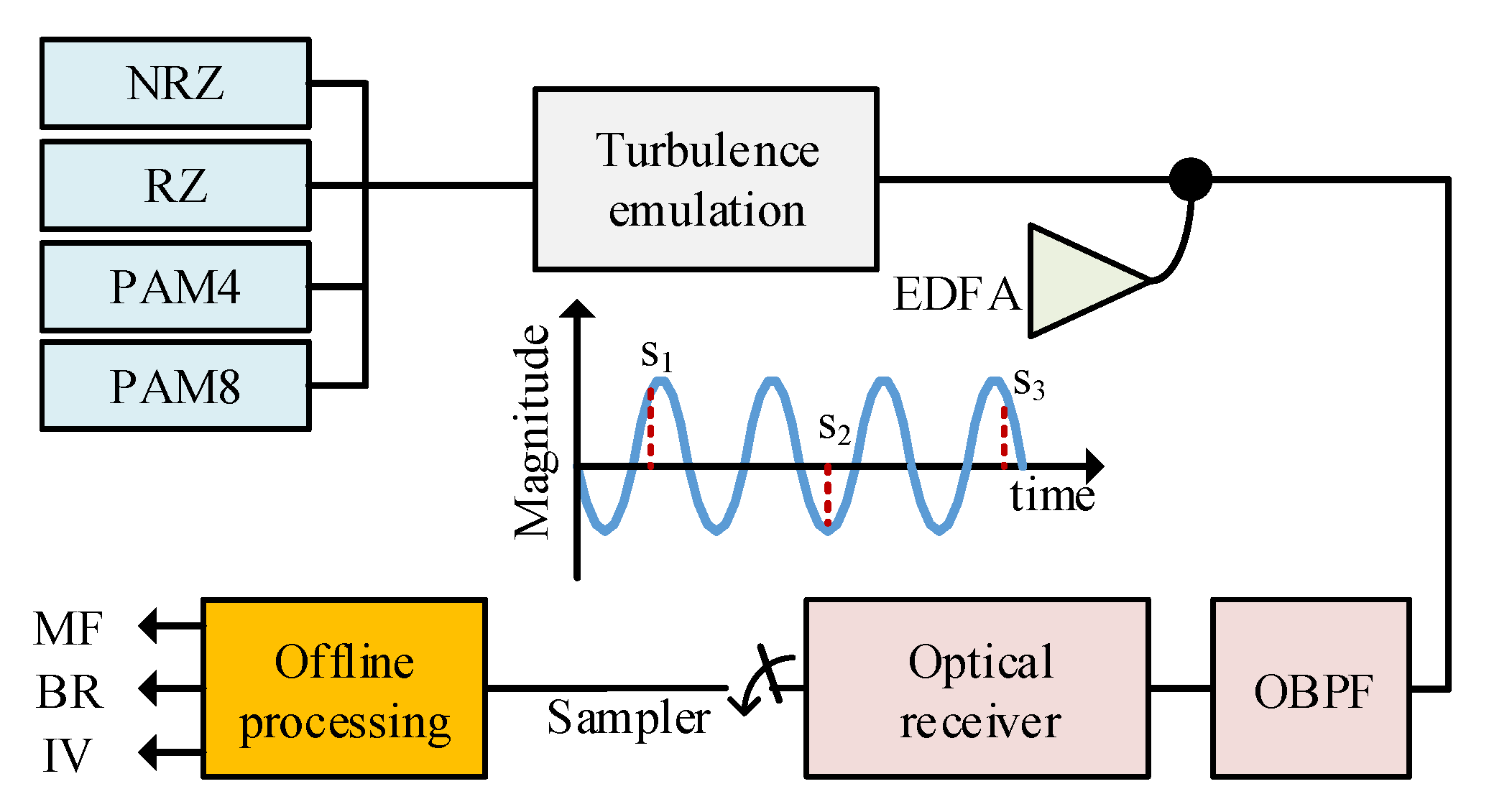

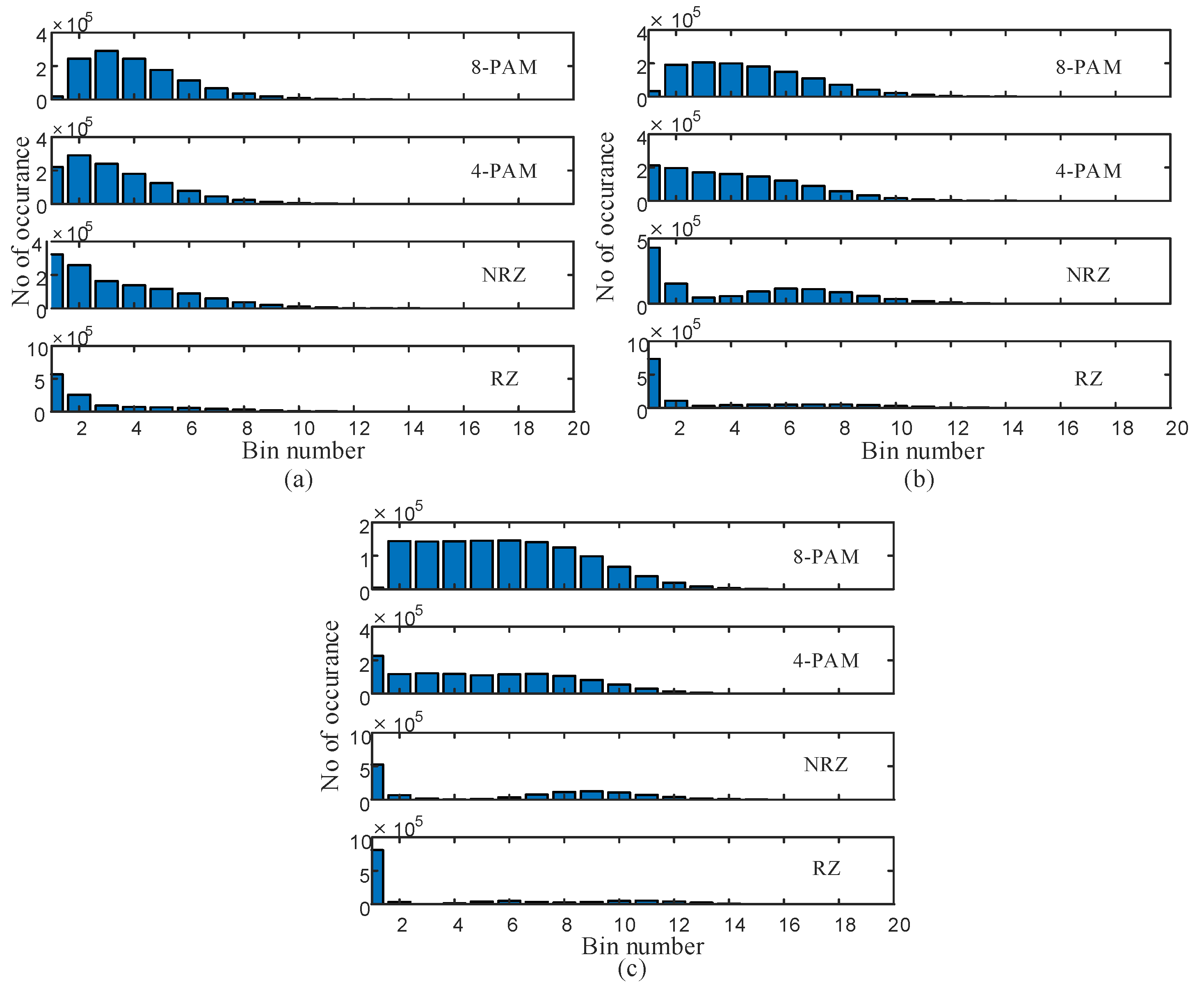
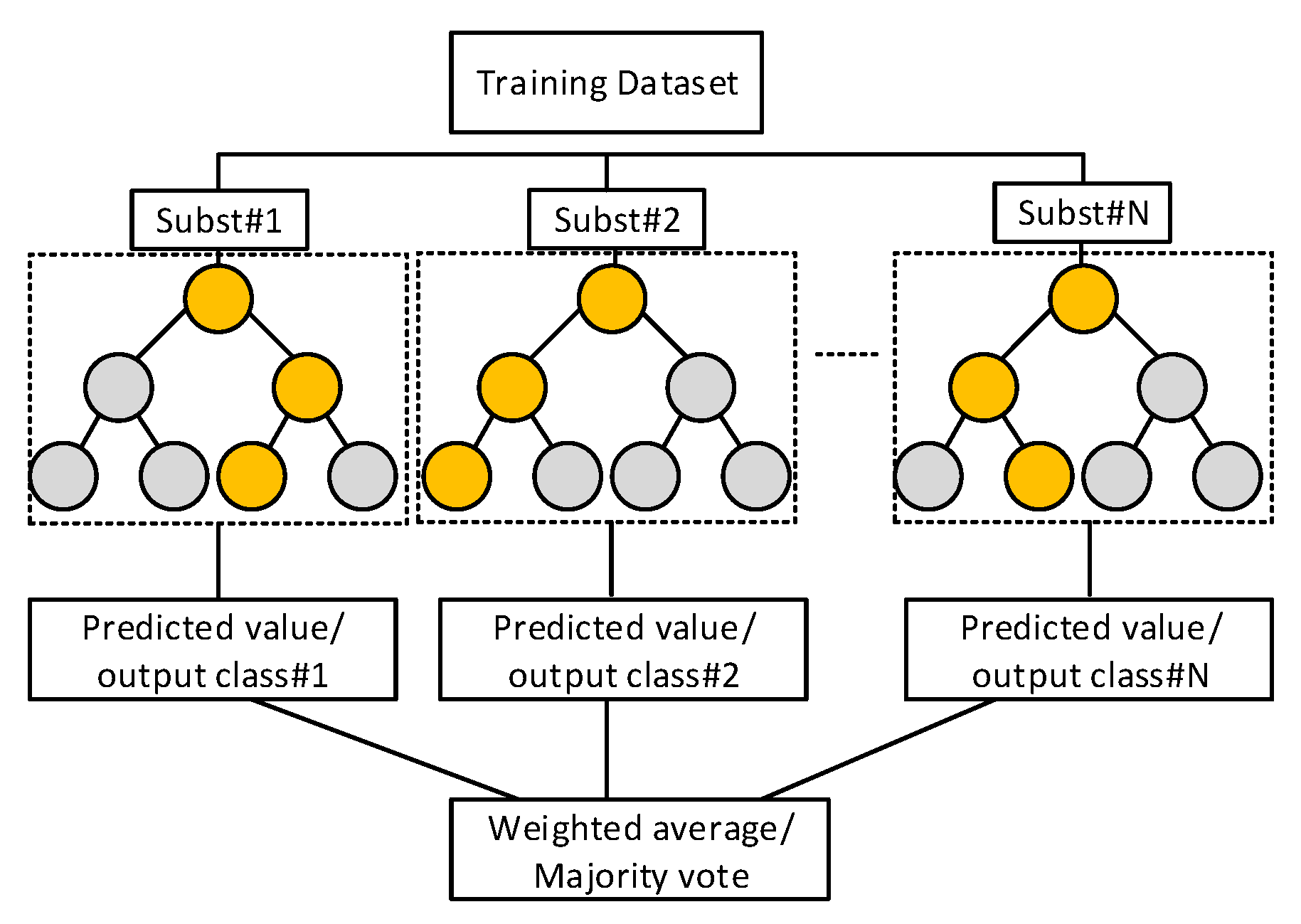
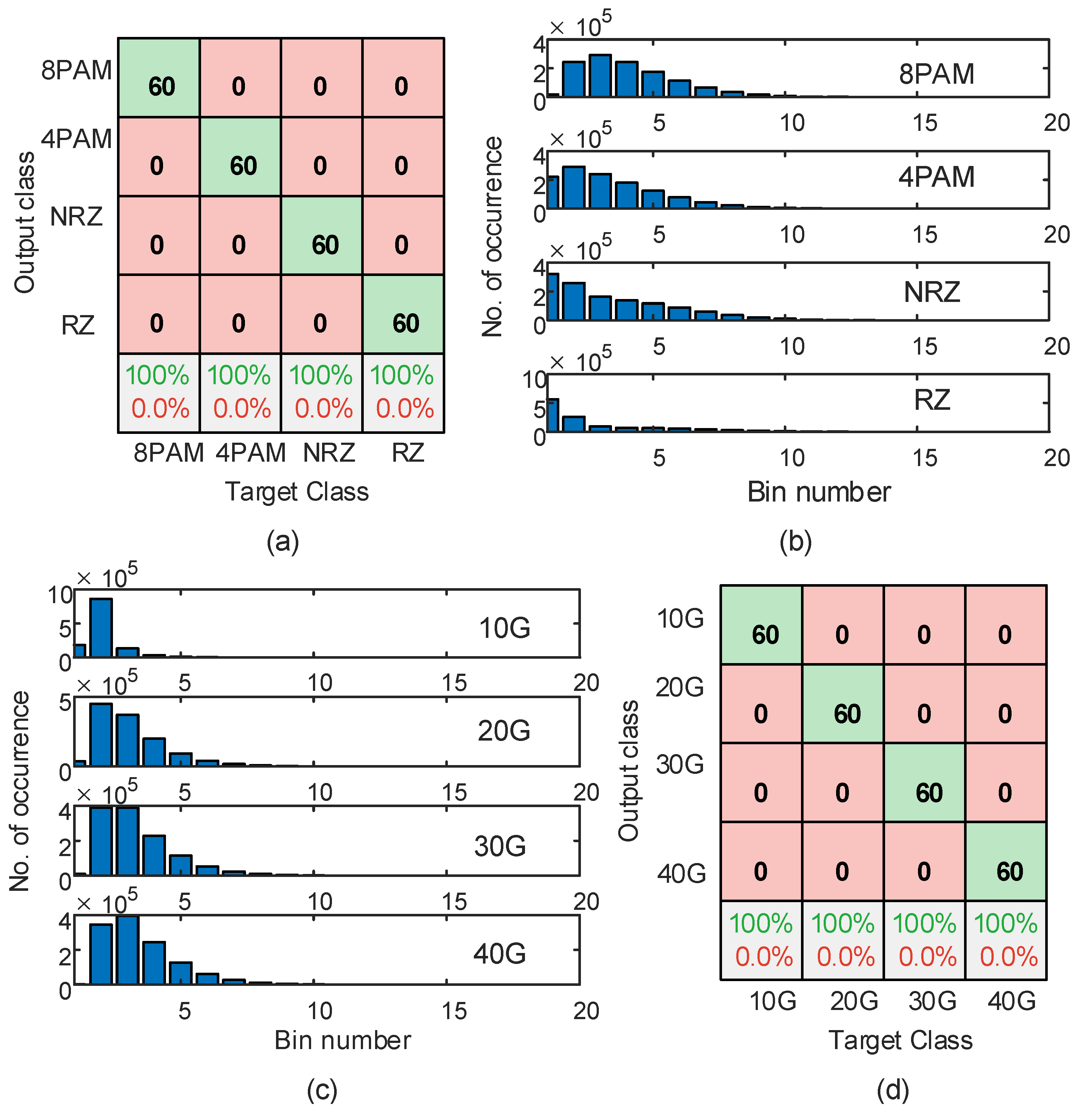
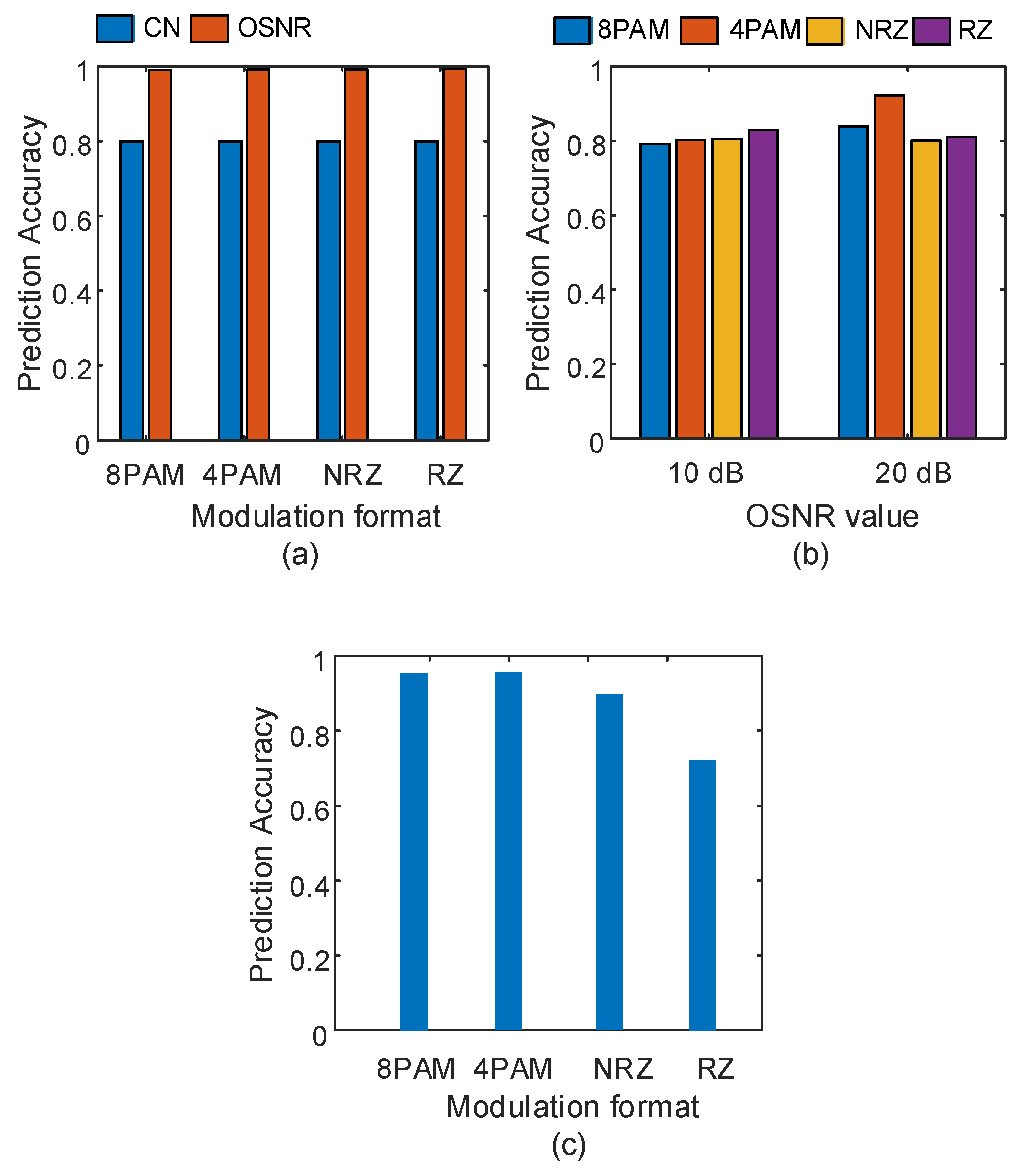
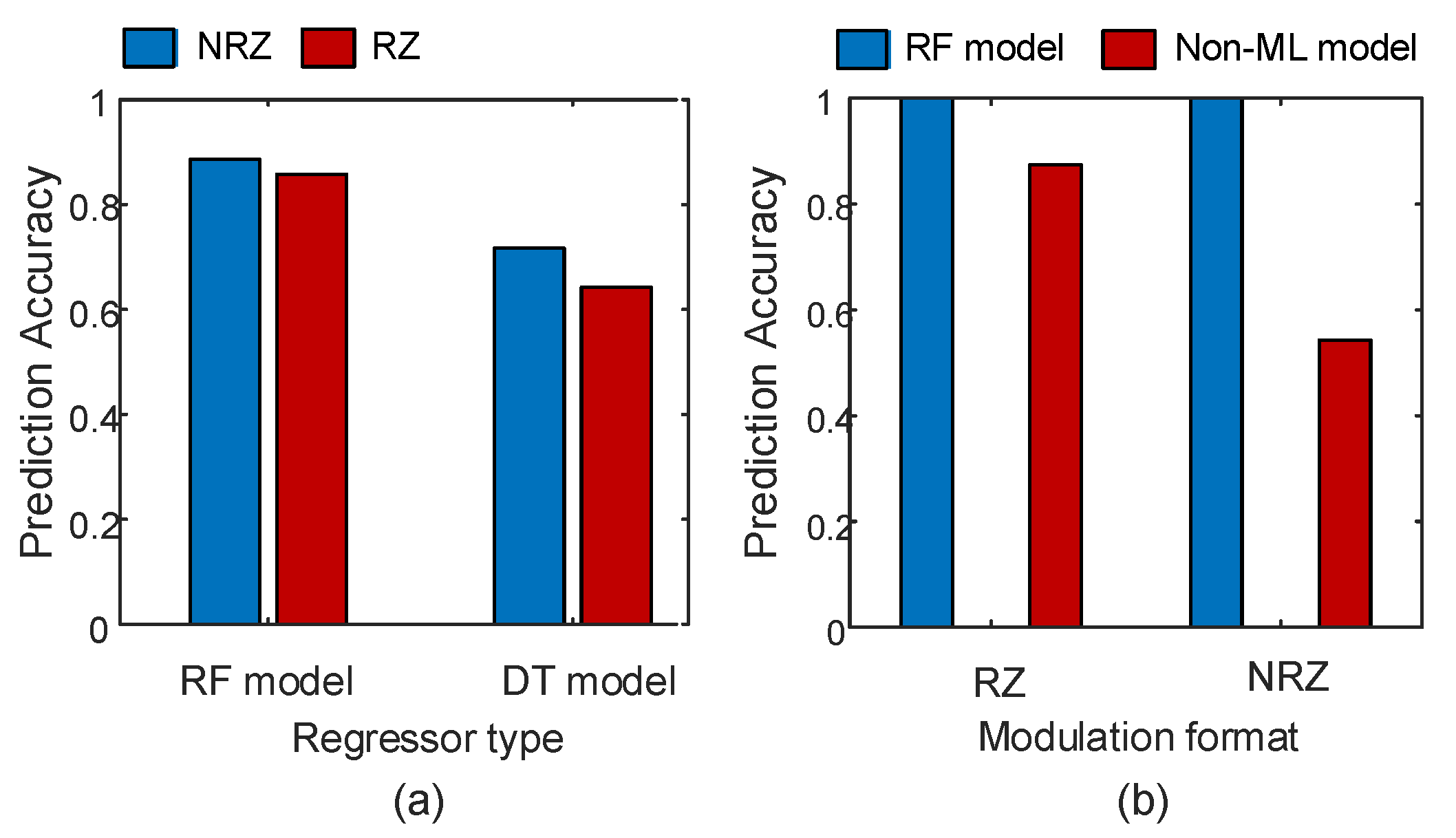
| Refs. | Channel Type | ML Model | Training Feature | Modulation Classification? | Baud Rate Classification? | Monitored Parameters |
|---|---|---|---|---|---|---|
| [13] | Fiber | PCA | ASCS | RZ-OOK NRZ-DPSK RZ-DPSK | No | OSNR |
| [14] | Fiber | CNN | Eye diagram | RZ-OOK NRZ-OOK RZ-DPSK 4-PAM | No | OSNR |
| [15] | Fiber | DNN | AH | NRZ-OOK 4-PAM 8-PAM | No | OSNR |
| [16] | Fiber | CNN | ASTS | NRZ-OOK RZ-OOK NRZ-DPSK | Yes | OSNR CD DGD |
| [17] | Fiber | PCA | ADTS | RZ-OOK DP-RZ-QPSK DP-NRZ- 16QAM | Yes | OSNR CD DGD |
| [18] | FSO | CNN | OAM modes | No | No | Turbulence |
| [19] | FSO | CNN | OAM modes | No | No | Turbulence |
| [20] | FSO | CNN | OAM modes | No | No | Visibility |
| [21] | FSO | SVM | OAM modes | No | No | Visibility |
| [22] | FSO | SVM+ CNN | AAH+ ADTS | No | No | Turbulence, OSNR, Pointing errors |
| This work | FSO | RF | AAH | NRZ OOK RZ OOK 4-PAM 8-PAM | Yes | Turbulence OSNR |
Disclaimer/Publisher’s Note: The statements, opinions and data contained in all publications are solely those of the individual author(s) and contributor(s) and not of MDPI and/or the editor(s). MDPI and/or the editor(s) disclaim responsibility for any injury to people or property resulting from any ideas, methods, instructions or products referred to in the content. |
© 2023 by the author. Licensee MDPI, Basel, Switzerland. This article is an open access article distributed under the terms and conditions of the Creative Commons Attribution (CC BY) license (https://creativecommons.org/licenses/by/4.0/).
Share and Cite
Esmail, M.A. Autonomous Self-Adaptive and Self-Aware Optical Wireless Communication Systems. Sensors 2023, 23, 4331. https://doi.org/10.3390/s23094331
Esmail MA. Autonomous Self-Adaptive and Self-Aware Optical Wireless Communication Systems. Sensors. 2023; 23(9):4331. https://doi.org/10.3390/s23094331
Chicago/Turabian StyleEsmail, Maged Abdullah. 2023. "Autonomous Self-Adaptive and Self-Aware Optical Wireless Communication Systems" Sensors 23, no. 9: 4331. https://doi.org/10.3390/s23094331
APA StyleEsmail, M. A. (2023). Autonomous Self-Adaptive and Self-Aware Optical Wireless Communication Systems. Sensors, 23(9), 4331. https://doi.org/10.3390/s23094331






